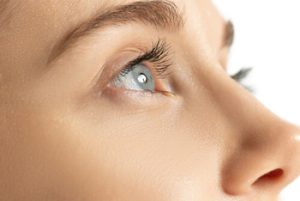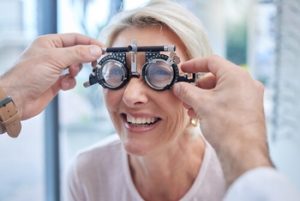Vision changes can happen so gradually that it’s easy to dismiss them. Maybe reading has become more challenging, or lights at night seem unusually bright. If these issues sound familiar, you may be wondering: Could your vision problems be cataracts’ symptoms?
In this article, we’ll explore how cataracts affect your eyes, how to recognise early signs, and what you can do to protect your vision. Whether you’re over age 60 or simply noticing new visual difficulties, this guide will help you feel informed and empowered.
What Are Cataracts?
Cataracts are a common eye disease where the eye’s clear lens becomes cloudy, leading to visual changes. This clouded lens interferes with how light passes through the eye, making it harder to focus clearly.
Cataracts typically develop slowly, often without causing pain or sudden symptoms, which is why regular eye exams are crucial.
Understanding Cataract Symptoms
The symptoms of cataracts can manifest in various ways and often resemble those of other vision problems. Knowing what to look for can help you seek care sooner and stay ahead of any changes in your eyesight.
Common signs of cataracts include:
- Blurry vision that doesn’t improve with a new prescription
- Increased glare or halos around lights, especially when driving at night
- Reduced night vision, making it harder to see in low-light conditions
- Colours appearing duller or yellowed
- Sensitivity to light, including bright sunlight or indoor lighting
- Double vision in one eye
- Regular changes in glasses or contact lens prescriptions
- Needing brighter lights to read or do close-up work
If you notice any changes, a comprehensive eye exam can help detect cataracts early.
Could It Be Something Else?
While cataract symptoms are common, they’re not the only cause of vision changes. Issues like dry eyes, macular degeneration, or glaucoma can also affect your eyesight. That’s why it’s important not to self-diagnose. Your eye doctor can assess what’s really going on and guide you through the next steps.
How Cataracts Can Make Daily Life Difficult
If you’re experiencing symptoms of cataracts, you may have found yourself:
- Avoiding driving at night due to sensitivity to light
- Struggling to read without a strong lamp
- Wearing sunglasses more often than before
- Finding that your new glasses still don’t help enough
- Noticing that you can’t see faces clearly in dim light
- Needing to sit closer to the screen when watching TV
These are signs that cataracts can have a significant impact on your quality of life, even if they’ve developed slowly over time.
Cataracts And Emotional Well-Being
Cataracts don’t just affect your sight; they can influence how you feel. Many people report feeling frustrated, disconnected, or less confident as their vision problems worsen. You may feel hesitant to go out at night or participate in activities you once enjoyed.
Recognising this emotional toll is just as important as noticing physical symptoms. Taking steps to support your eye health is also a way to support your overall well-being.
What Are The Risk Factors Of Developing Cataracts?
Several factors may increase your risk of developing cataracts. These include:
- Ageing (most people develop them after the age of 60)
- A family history of cataracts
- Past eye injuries or previous eye surgery
- Prolonged use of corticosteroid medicines
- Too much alcohol
- Exposure to ultraviolet light without proper eye protection
- Certain health problems, such as diabetes
- Smoking
- Some medications or treatments, such as radiation
Being aware of these risk factors allows you to make informed lifestyle choices and monitor your vision more closely.
Lifestyle Cataract Surgery: What To Expect
More than just removing a cloudy lens, this type of surgery focuses on supporting your vision goals, helping you return to the activities you love with greater ease and clarity.
This personalised approach considers how you use your eyes throughout the day, whether you’re reading, driving, using screens, or enjoying the outdoors, and matches your treatment to your lifestyle.
Here’s what the process looks like from consultation to recovery:
Step 1: Personalised Consultation
Your journey begins with a comprehensive consultation with your eye surgeon or ophthalmologist. This appointment will include:
- A detailed eye examination to confirm the presence and progression of the cataract
- Discussion of your cataract symptoms and how they affect your everyday life
- Assessment of your overall eye health and any other vision problems
- A conversation about your lifestyle needs and visual preferences
You’ll have the opportunity to ask questions, raise concerns, and learn about your intraocular lens (IOL) options. Your doctor will also explain how the surgery works, what to expect, and how long recovery might take in your case.
Step 2: Choosing The Right Intraocular Lens (IOL)
One of the key differences with lifestyle cataract surgery is the ability to choose an IOL that aligns with how you want to see the world.
The options include Multifocal (MF) and Extended Depth Of Focus (EDOF) Lenses designed to support both near and distance vision, reducing your dependence on glasses.
Your doctor will help you understand each type and recommend one based on your preferences, occupation, hobbies, and how much you rely on glasses.
Step 3: The Day Of Your Surgery
Cataract surgery is typically a day procedure performed under local anaesthesia. Here’s what usually happens:
- The team will apply numbing eye drops to keep your eye comfortable.
- Using advanced technology, your surgeon will gently remove the clouded lens.
- The artificial lens (IOL) will be inserted into the same position as your natural lens.
- Most procedures are completed in under 30 minutes.
You’ll be monitored briefly after surgery and will usually go home the same day with guidance on how to care for your eyes.
Step 4: Your Recovery Journey
Recovery from lifestyle cataract surgery is typically smooth, and many people notice improvements in their vision within the first few days.
During this time:
- You’ll be given eye drops to support healing and reduce inflammation
- Your surgeon will provide clear instructions on caring for your eyes
- You’ll attend follow-up appointments to ensure everything is healing well
- Most people return to light activities within a few days
You may be asked to avoid strenuous movement, heavy lifting, or getting water into your eye for a short period. Your eye doctor will let you know when it’s okay to return to work, exercise, or do more visually demanding tasks.
Step 5: Enjoying A Visual Lifestyle That’s Right For You
The goal of lifestyle cataract surgery isn’t just to remove the cloudy lens; it’s to help you regain clarity in a way that fits your life. Whether that means reading without glasses, enjoying night drives, or simply experiencing colours more vividly, the outcome is tailored to your goals.
With support from your eye care team and a well-chosen IOL, you can return to the activities you enjoy with renewed comfort and confidence.
How To Prevent Cataracts Or Delay Their Progression
Although there’s no guaranteed way to prevent cataracts, you can take steps to protect your eyes and slow their development by understanding what causes cataracts.
Simple prevention tips include:
- Wear sunglasses that block 100% of UV rays
- Avoid smoking
- Eat a diet rich in antioxidants, leafy greens, and healthy fats
- Limit alcohol consumption
- Stay on top of health problems like diabetes
- Avoid prolonged use of medications that may affect your eyes
- Schedule regular eye examinations, especially if you’re over 40
These habits support long-term eye health and help you stay proactive.
Frequently Asked Questions
Can cataracts return after surgery?
Once the cataract is removed, it won’t return. However, a secondary clouding of the lens capsule may occur and can be treated with a quick laser procedure.
Can younger people develop cataracts?
Yes. While cataracts are more common after the age of 60, they can also develop in younger people. Your eye surgeon will guide you.
Do cataracts usually develop in both eyes?
Yes, most cataracts develop in both eyes, but not always at the same time or at the same rate. One eye may show symptoms of cataracts earlier than the other. Each eye is assessed and treated individually by your eye doctor.
Conclusion
The good news is that there are supportive and effective steps you can take. A trusted eye doctor can help assess your situation and walk you through your options so that you can restore your clear vision.
If you’ve been experiencing changes in your eyesight or recognise any signs of cataracts, it may be time to speak with a trusted eye care professional.
Our team is here in Melbourne to guide you, whether you’re ready to explore lifestyle cataract surgery or simply want to understand your options.
Book your eye examination with Eye Laser Specialists today at 03 9070 5788 or 03 9070 0910 and take a positive step towards seeing the world more clearly and comfortably.
Note: Any surgical or invasive procedure carries risks. Before proceeding, you should seek a second opinion from an appropriately qualified health practitioner.
Sources
Gurarie M. What Are Cataracts? [Internet]. Health. 2023 [cited 2025 Jun 19]. Available from: https://www.health.com/cataracts-overview-7376241
WebMD Editorial Contributors. What Are the Symptoms of Cataracts? When Should I Call the Doctor? [Internet]. WebMD. 2025 [cited 2025 Jun 19]. Available from: https://www.webmd.com/eye-health/cataracts/symptoms-of-cataracts-when-to-call-the-doctor
Xu Y, Liang A, Zheng X, Huang Z, Li Q, Su T, et al. Sex-Specific Social, Lifestyle, and Physical Health Risk Factors in Cataracts Development. Eye [Internet]. 2024 Jul 29;38(15):2939–46. Available from: https://www.nature.com/articles/s41433-024-03193-z
Bedinghaus T. Multifocal Intraocular Lenses for Cataract Surgery [Internet]. Verywell Health. 2025 [cited 2025 Jun 19]. Available from: https://www.verywellhealth.com/intraocular-contact-lenses-3421653







